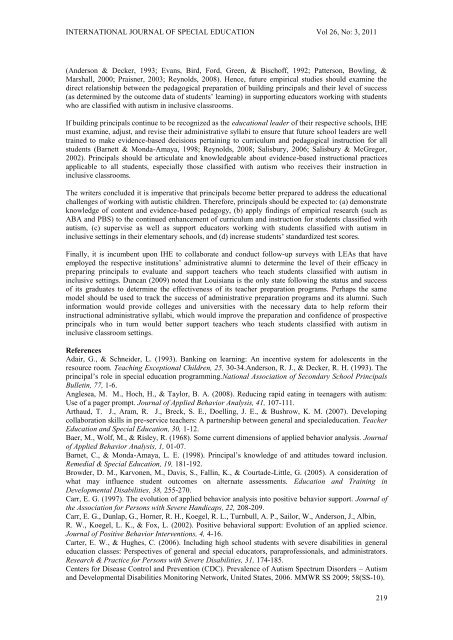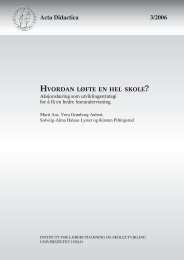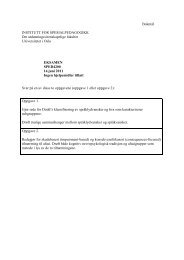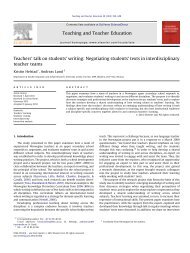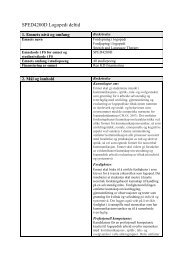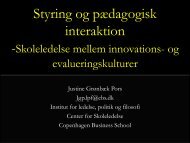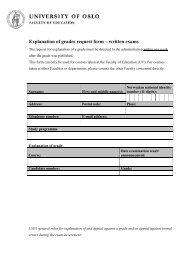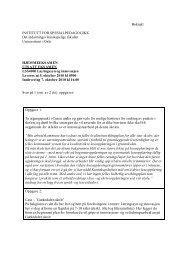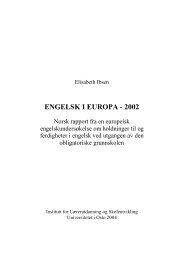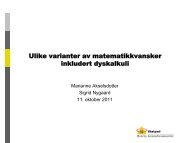International Journal Special Education
International Journal Special Education
International Journal Special Education
Create successful ePaper yourself
Turn your PDF publications into a flip-book with our unique Google optimized e-Paper software.
INTERNATIONAL JOURNAL OF SPECIAL EDUCATION Vol 26, No: 3, 2011(Anderson & Decker, 1993; Evans, Bird, Ford, Green, & Bischoff, 1992; Patterson, Bowling, &Marshall, 2000; Praisner, 2003; Reynolds, 2008). Hence, future empirical studies should examine thedirect relationship between the pedagogical preparation of building principals and their level of success(as determined by the outcome data of students’ learning) in supporting educators working with studentswho are classified with autism in inclusive classrooms.If building principals continue to be recognized as the educational leader of their respective schools, IHEmust examine, adjust, and revise their administrative syllabi to ensure that future school leaders are welltrained to make evidence-based decisions pertaining to curriculum and pedagogical instruction for allstudents (Barnett & Monda-Amaya, 1998; Reynolds, 2008; Salisbury, 2006; Salisbury & McGregor,2002). Principals should be articulate and knowledgeable about evidence-based instructional practicesapplicable to all students, especially those classified with autism who receives their instruction ininclusive classrooms.The writers concluded it is imperative that principals become better prepared to address the educationalchallenges of working with autistic children. Therefore, principals should be expected to: (a) demonstrateknowledge of content and evidence-based pedagogy, (b) apply findings of empirical research (such asABA and PBS) to the continued enhancement of curriculum and instruction for students classified withautism, (c) supervise as well as support educators working with students classified with autism ininclusive settings in their elementary schools, and (d) increase students’ standardized test scores.Finally, it is incumbent upon IHE to collaborate and conduct follow-up surveys with LEAs that haveemployed the respective institutions’ administrative alumni to determine the level of their efficacy inpreparing principals to evaluate and support teachers who teach students classified with autism ininclusive settings. Duncan (2009) noted that Louisiana is the only state following the status and successof its graduates to determine the effectiveness of its teacher preparation programs. Perhaps the samemodel should be used to track the success of administrative preparation programs and its alumni. Suchinformation would provide colleges and universities with the necessary data to help reform theirinstructional administrative syllabi, which would improve the preparation and confidence of prospectiveprincipals who in turn would better support teachers who teach students classified with autism ininclusive classroom settings.ReferencesAdair, G., & Schneider, L. (1993). Banking on learning: An incentive system for adolescents in theresource room. Teaching Exceptional Children, 25, 30-34.Anderson, R. J., & Decker, R. H. (1993). Theprincipal’s role in special education programming.National Association of Secondary School PrincipalsBulletin, 77, 1-6.Anglesea, M. M., Hoch, H., & Taylor, B. A. (2008). Reducing rapid eating in teenagers with autism:Use of a pager prompt. <strong>Journal</strong> of Applied Behavior Analysis, 41, 107-111.Arthaud, T. J., Aram, R. J., Breck, S. E., Doelling, J. E., & Bushrow, K. M. (2007). Developingcollaboration skills in pre-service teachers: A partnership between general and specialeducation. Teacher<strong>Education</strong> and <strong>Special</strong> <strong>Education</strong>, 30, 1-12.Baer, M., Wolf, M., & Risley, R. (1968). Some current dimensions of applied behavior analysis. <strong>Journal</strong>of Applied Behavior Analysis, 1, 01-07.Barnet, C., & Monda-Amaya, L. E. (1998). Principal’s knowledge of and attitudes toward inclusion.Remedial & <strong>Special</strong> <strong>Education</strong>, 19, 181-192.Browder, D. M., Karvonen, M., Davis, S., Fallin, K., & Courtade-Little, G. (2005). A consideration ofwhat may influence student outcomes on alternate assessments. <strong>Education</strong> and Training inDevelopmental Disabilities, 38, 255-270.Carr, E. G. (1997). The evolution of applied behavior analysis into positive behavior support. <strong>Journal</strong> ofthe Association for Persons with Severe Handicaps, 22, 208-209.Carr, E. G., Dunlap, G., Horner, R. H., Koegel, R. L., Turnbull, A. P., Sailor, W., Anderson, J., Albin,R. W., Koegel, L. K., & Fox, L. (2002). Positive behavioral support: Evolution of an applied science.<strong>Journal</strong> of Positive Behavior Interventions, 4, 4-16.Carter, E. W., & Hughes, C. (2006). Including high school students with severe disabilities in generaleducation classes: Perspectives of general and special educators, paraprofessionals, and administrators.Research & Practice for Persons with Severe Disabilities, 31, 174-185.Centers for Disease Control and Prevention (CDC). Prevalence of Autism Spectrum Disorders – Autismand Developmental Disabilities Monitoring Network, United States, 2006. MMWR SS 2009; 58(SS-10).219


